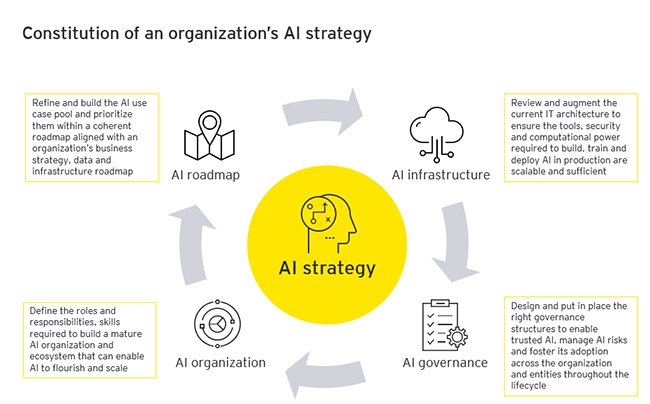THANK YOU FOR SUBSCRIBING

Developing An AI Strategy For Innovation At Scale
Hong Cao, Director, Consulting, at Ernst & Young (EY) and Ritin Mathur, Partner


Hong Cao, Director, Consulting, at Ernst & Young (EY)
Despite the significant impact, the COVID-19 pandemic accelerated the world’s digital transformation and changed the way that we live, work, learn and play.
During the pandemic, it was evident that countries and industrial sectors that harnessed digital technologies better were more resilient to the lockdowns than others that did not do so. Countries that innovated more quickly also found themselves in a better position to manage their pandemic logistics, such as virus tracing, responding to outbreaks more quickly and having better enforcement of social-distancing policies. People also spent more time on digital technologies and interacted more often through digital channels; they also became more receptive toward new digital solutions, apps and cloud technologies.
These changes paved the way for the next big opportunity for organizations to fast-track their digital transformation post-pandemic.
However, for digital transformation to be truly high impact, organizations need to relook at their artificial intelligence (AI) strategy, which holds the promise to bring the right insights to the right people and at the right time for their informed decision-making.
According to the EY enterprise AI survey 2022, which covered over 1,700 executives around the world, 15% of the companies surveyed expect AI adoption to be scaled across their organizations. Further, 96% of the respondents believed that their organization’s AI expenditure will increase in the next 18 months, with 45% expecting their annual AI expenditure to increase by 50% or more. These findings underscore the potential for organizations to leverage and scale up their use of AI .
However, to ensure that the AI innovation is focused and has good return of investment, there is a need for an actionable AI strategy. This strategy needs to be created, communicated, endorsed by the C-level leaders and supported by the business function leads. The AI strategy should encompass four key areas: the roadmap, infrastructure, governance and organization.
AI Roadmap
The roadmap provides a pathway to identify the most promising AI use cases and incorporates them into future development cycles. Often, most of the use cases are contributed bottom-up from various functions across the organization, with the key attributes of each use case documented.
Some of the core attributes are around the business context, description of the current challenge or opportunity, description of how AI can help and the data sets needed. Each use case is then evaluated for its potential business impact and ease of implementation. For business impact, the use cases are assessed on their alignment to business strategy and the quantum of positive impact to key business metrics upon successful development. For ease of implementation, several aspects like complexity of algorithm, availability of data and technology, ease of integrating into the business process are considered.
An implementation roadmap prioritizes the development of use cases that score high on ease of implementation and have a high business impact. It is always good to start with low-hanging and high-impact use cases for implementation. These quick wins create confidence and awareness within the organization to sustain the AI initiative and attract more people to be involved in the AI journey.
AI Infrastructure
This entails a plan to identify IT infrastructure gaps and bridge them to support the AI development. Data platforms should support not just AI development, but also deployment and ongoing monitoring. Without the foundation of a realistic deployment and monitoring strategy, most AI solutions do not deliver the impact they were designed for and stop early at their research phase. Additionally, there are other common issues that a data platform can fall short in supporting real-time streaming-based AI consumption, AI cataloging, AI collaboration, and AI model performance monitoring and supercomputing needs.
To optimize a current data platform to support AI or to develop a fresh new AI platform, the infrastructure strategy needs to evaluate, acknowledge and bridge the technology gaps to support the AI roadmap. For a seamless implementation, often setting up the machine learning operations (MLOPs) is an important part of AI infrastructure strategy. This refers to using standardized and automated processes and pipelines to continuously integrate, deliver and deploy AI models into the production environment. Infrastructure for AI should not be an afterthought and must be proactively planned to support various use cases defined in the AI roadmap.
AI Governance
It is important to manage the AI risks throughout the lifecycle and ensure compliance to the organization’s policy and industrial standards. AI risks can exist in four areas, namely in the design, data, algorithm and performance:
 Ritin Mathur, Partner
Ritin Mathur, Partner
• Design risk is tied to the business problem statement. A good understanding of the business problem is essential for AI practitioners to design and formulate the most appropriate AI-driven solution to solve.
• Data risk is pervasive, given that AI is driven by data. Data risks should be identified early in the AI solution and managed through data validation and AI model design, and vigilantly monitored when the AI solution is deployed.
• Algorithmic risk arises from the choice of machine learning (ML) algorithms. It is important to choose ML models that not only give outcomes aligned to the business needs, but are also resistant to malicious attacks. Each ML algorithm has its built-in mechanism to learn from data. It is important to choose and validate an algorithm that is best suited to input data characteristics for maximized accuracy. One should note that AI models can be vulnerable to four types of malicious attacks, including inference attacks, model extraction attacks, adversarial attacks and poisoning attacks . Safeguarding AI models against these attacks is necessary for mission-critical AI systems.
• Performance risk is tied to drift of the input data and model. For mitigating such a risk, a feedback loop shall be created to continuously monitor the model performance and refresh the model with new data as needed.
To manage the AI risks consistently in a dynamic setting, an easy-to-use AI governance framework should be designed with standard processes, checklists, and tools to manage the abovementioned AI risks throughout its lifecycle.
According to the EY enterprise AI survey 2022, which covered over 1,700 executives around the world, 15% of the companies surveyed expect AI adoption to be scaled across their organizations
AI Organization
To drive the AI agenda forward in an organization, a focus is needed on designing the right organization structure, defining roles and responsibilities and developing a competency and skills framework. Humans are at the center of any strategy execution. For the AI strategy to be effective, the organizational workforce should be literate in data and AI, with a good understanding of the benefits that AI can bring while also being aware of its limitations. Tactically, there needs to be a taskforce of AI experts, data architects and business domain specialists to actively drive the AI agenda, support various AI initiatives, govern the AI solutions and assets, and foster collaboration between businesses and innovators.
At the organization level, the leaders should steer the organization toward an innovation-friendly culture that is open, forward-looking, fact-driven, pragmatic and business outcome-oriented. The innovation process should be agile, allowing AI projects to start small, fail fast and accumulate the learning to restart again.
The AI strategy guides organizations in their AI journeys through a focused and organized manner, and should be a “living guide” that is regularly reviewed and updated to remain relevant amid the fast-changing market environments and disruptive technologies.
Weekly Brief
I agree We use cookies on this website to enhance your user experience. By clicking any link on this page you are giving your consent for us to set cookies. More info
Read Also
Empowering Educators with Faith, Excellence and Purpose
Leading with AI: From Ethics to Enterprise Impact
Done Today Beats Perfect Tomorrow: The New IT Advantage
The Shift from Cybersecurity to Product Security: A Business Imperative
Advancing Retail through E-Commerce, Cloud and Cybersecurity
Transforming Risk Management into Strategic Business Advantage
Designing Future-Ready, People-Centered Workplaces
Shaping Customer Experience Through Smarter Logistics




















